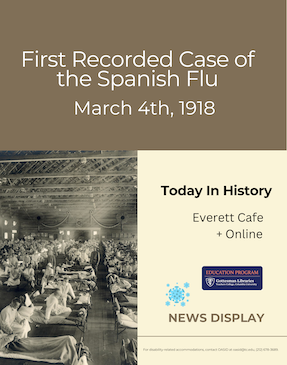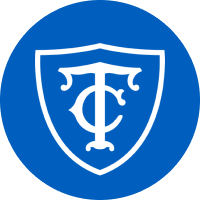Today In History: First Recorded Case of the Spanish Flu

On March 4th, 1918 at Fort Riley in North Central Kansas, Private Albert Gitchell, reported symptoms of a sore throat, fever, and headache. Similar symptoms soon spread throughout the base among 100 additional soldiers, with outbreaks then to follow in army camps and prisons throughout the country -- and then quickly to Europe as soldiers made their way to the battlegrounds of World War One. People referred to the Great Influenza Pandemic of 1918-1920 as the "Spanish Flu," believing it originated in Spain. It was one of the deadliest pandemics in history, claiming as many as 50 million lives, many of them young adults.
The Spanish Flu struck in waves, the second of which entailed bacterial pneumonia. Unlike the first wave, which meant a long deathbed, the second wave resulted in rapid death (a matter of hours or days) due to the effect of excessive fluid in the lungs. Third and fourth waves followed, spreading from Europe to South America. In many cities public gatherings were prohibited.
Although China was less affected by the Spanish Flu, leading research scientist Claude Hannoun of the Pasteur Institute believed it came from there and then mutated near Boston before spreading to Europe and elsewhere.
It was not until after the Second World War that the first flu vaccine was approved for greater use. At the time of the Spanish Flu, people wore masks and devised precautions, but they were not enough to mitigate the pandemic.
Other major influenza pandemics included: the 1957-58 Asian Flu and 1968-69 Hong Kong Flu.
The following articles are drawn from Proquest Historical Newspapers, which informs and inspires classroom teaching and learning.
- Symptoms of Spanish "Flu": Health Service Bulletin Gives History of Epidemic Now Raging. (1918, Oct 06). Courier-Journal (1869-1922)
- Germ "Explosions" That Shook a Continent: The Influenza Epidemic Came Out of Asia, Where All the World Plagues Are Hatched, and Swept Westward Across the World, Says Medical Writer. (1919, May 25). New - York Tribune (1911-1922)
- Smith, C. (1961, Mar 12). Books: The Appalling 'Flu' Epidemic of 1918. The Sun (1837-)
- Stovall, I.S. (1976, Mar 07). Recalling a Real Epidemic: 1918 Spanish Flu. The Washington Post (1974-)
- Taylor, C. S. (1976, Apr 23). Spanish Flu of 1918 Killed 21 Million Persons: U. S. Deaths More Than From War. Atlanta Daily World (1932-)
- Crosby, A.W. (1976, Aug 05). Is Medical History Repeating Itself. Newsday (1940-)
- Schmeck, H. M. . (1976, Sep 10). Campaign on Swine Flu Virus Recalls the Pandemic of 1918. New York Times (1923-)
- Kolata, G. (1997, Mar 21). Genetic Material of Virus From 1918 Flu Is Found. New York Times (1923-)
- Davies, P. (1999, Aug 07). The Plague In Waiting. The Guardian (1959-2003)
- Barry, D., & Dickerson, C. (2020, Apr 05). The Silent Killer of 1918: A Philadelphia Story: Ravages of Spanish Flu lLve on in Memories. New York Times (1923-)
- Roche, B. (2020, Apr 06). Spanish Flu Survivor Sees Historic Lessons: John Walsh Says It Was 'Nothing Like as Regimented' in 1918-1919 As It Is Today. The Irish Times (1921-)
- FitzGerald, J. (2020, Apr 24). Forgotten Lessons of the Spanish Flu Pandemic: Economics. The Irish Times (1921-)

Tips:
- Byerly, Carol R. Fever of War : The Influenza Epidemic in the U.S. Army During World War I. New York, NY: New York University Press, 2005. e-book
- Johnson, Niall. Britain and the 1918-19 Influenza Pandemic : A Dark Epilogue. London ; Routledge, 2006. e-book
- Killingray, David., John S. Oxford, Howard. Phillips, and Terry. Ranger. Spanish Influenza Pandemic of 1918-1919 : New Perspectives. London: Routledge, 2003. e-book
- Walters, Mark Jerome. Seven Modern Plagues and How We Are Causing Them. 1st ed. Washington, DC: Island Press, 2014. e-book
- Winters, Cat. In the Shadow of Blackbirds. New York: Amulet Books, 2013. Juvenile ; PZ7.W76673 In 2013
Images:
- Spanish Flu Poster, Alberta, Courtesy of Wikimedia Commons
- Poster Image: Emergency Hospital During Influenza Epidemic, Camp Funston, Kansas - NCP 1603, Courtesy of Wikimedia Commons
Need to keep current, look to the past, teach a topic? The Everett Cafe features daily postings of news from around the world, and also promotes awareness of historical events from an educational context. Be sure to check additional Cafe News postings on the library blog.

